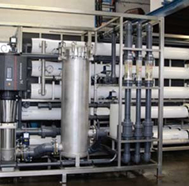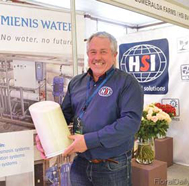 Osmosis is the passing of a liquid through a membrane from a lesser concentration to a greater concentration. Eventually, both liquids would be of equal concentrations. Figure 1, page 48, demonstrates how this reaction takes place. A good example of osmosis is how plants uptake water.
Osmosis is the passing of a liquid through a membrane from a lesser concentration to a greater concentration. Eventually, both liquids would be of equal concentrations. Figure 1, page 48, demonstrates how this reaction takes place. A good example of osmosis is how plants uptake water.
Reverse osmosis (RO) puts pressure on the greater concentrated liquid and forces it through the membrane to the lesser-concentrated liquid, hence the term, reverse osmosis. The membrane traps particles and impurities down to 0.0009 micron, and the effluent or permeate water is very clean and free from impurities. Figure 1 demonstrates how this works. So at its most basic level, reverse osmosis filters impurities from a liquid, namely water.
By starting with water that is free from impurities and minerals, RO water can help make growing more calculable, since the water quality is constant. Nutrients can be better controlled without having to worry about what is in the water source at the beginning of the irrigation process. Contaminants in the water source, such as iron, manganese, calcium, magnesium and chlorine, can react with the nutrients and cause problems with fertilizer mix.
Growing Without Contaminants Growing with good water and adding nutrients at the grower’s discretion make growing more calculable. Not having iron, manganese, calcium or magnesium makes setting up the EC of a nutrient solution easier since the fertilizers are not reacting with the impurities in the water.
The only nutrient minerals that are added to the irrigation water are ones that are an advantage to the plant. Total dissolved solids (TDS) reveals the conductivityof water, but EC measures the actual electrical production of these minerals. Water that is pure will not conduct electricity or have an EC and TDS reading.
Purchasing Tips
The implementation of RO can be quite ambiguous, and cost considerations are the most objectionable. Plus, wastewater is another downside of this technology.
 There are two types of membranes that are used in ROdesigns, and each has their uses and limits. The cellulose triacetate membrane does not offer the rejection rate of thin film composite (TFC) membranes. However, chlorine can break down TFC membranes faster and cause premature failure of the system, so a carbon pretreatment is recommended to remove chlorine.
There are two types of membranes that are used in ROdesigns, and each has their uses and limits. The cellulose triacetate membrane does not offer the rejection rate of thin film composite (TFC) membranes. However, chlorine can break down TFC membranes faster and cause premature failure of the system, so a carbon pretreatment is recommended to remove chlorine.
Pretreatment of the influent water must be considered or the membranes will foul out. Failure to address the pretreatment issue can cause extensive maintenance and labor costs. Without pretreatment, membranes become clogged and need to be replaced or cleaned sooner than normal. When used with softened water, the membranes last longer, since other minerals are removed before reaching the system. The use of a softener creates more cost and lab or when utilizing RO but must be considered to offset the higher cost of membrane replacement, lab or and downtime of the water treatment system.
Another factor to consider when using RO is the wastewater that is created. In general, depending on pressure and size of the unit, 4 gal. of water are required to produce 1 gal. of RO water. This would not be a good treatment option in areas where water use is restricted. There are newer systems on the market that are more efficient and produce less waste, but forthe amount of water a grower needs, these systems have a long way to go before being adopted within the industry.
RO water is very aggressive, since it does not contain any minerals, and can be very corrosive, especially to metal piping. RO water should never be run through galvanized or copper pipes because they will be destroyed by the water’s aggressive nature. Pipes, tubing, drippers, misters and foggers must be able to stand up to RO water.
System Sizes and Costs
The size of an RO water system varies greatly from manufacturer to manufacturer. There are a few factors to consider when looking at cost, namely how much water is needed per day. Most systems are rated on thenumber of gallons per day (GPD) that the system can produce. Residential systems can produce anywhere from 15-50 GPD without a pressure pump, the cost ranges from $200-600 and the rejection rates are acceptable. A system with a pressure pump can produce 75-150 GPD for $800-1,000, but their rejection rates are even greater because of the extra pressure.
Commercial and industrial RO systems escalate in price, but so does the volume of water being produced and the need for high-pressure pumps and large storage tanks. These systems can produce volumes of water ranging from a few thousand gallons per day to more than several hundred thousand per day. The costs vary from application to application and manufacturer to manufacturer. Keep in mind the storage areas for large amounts of processed water need to be addressed, and areas built for tanks increase the cost of the investment.
In Conclusion
Most growers, especially new or inexperienced ones, would benefit from most any type of water treatment that removes impurities. Removal of contaminants that promote microbial growth, such as iron and bacteria, can make a huge difference in growing, and the impact would be seen from reduced root rot problems, such as Pythium or fungal diseases that are introduced by water-borne bacteria. Propagation areas seem to be where most growers target their water treatment strategies, but many are incorporating treatment in other areas as well.
RO would be a great asset to any grower, as nutrient solutions could be controlled and calculated for a variety of crops and duplicated for consistency. RO is usually a hefty initial investment, but if incorporated correctly, it can have a fast return on investment.


